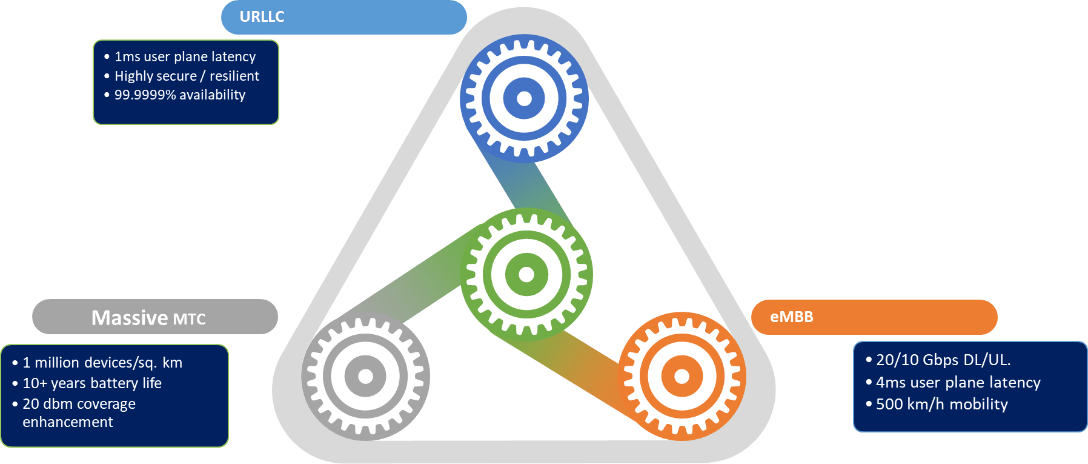Contents
Introduction about 5G:
Technology is at its greatest when it can connect not only humans but also machines and sensors. 5G is among the most advanced technologies that would transform communication between humans, machines, and sensors to realize a connected, smarter, and a safer world.
The rapid evolution of technology has transformed our lives by enabling instant communication and interaction, easy access to information, and enabling a better quality of life.
The transition to 5G redefines services by implementing SBA (services-based architecture), AI/ML, and software-defined networks, which would enable economic growth through use cases like Virtual/Augmented reality, machine communications, telemedicine, smart manufacturing, smart utilities, and smart cities.
Mobile network evolution.
Communication networks have come a long way since the introduction of first-generation mobile networks in the 1980s. Since then, additional services and higher throughputs have constantly been driving newer generations of mobile networks through GPRS/EDGE, HSPA/HSPA+, LTE/LTE-A Pro, and now the fifth generation network that is commonly referred to as 5G or New Radio (NR).

It is essential to note that intelligent devices – smartphones, wearables, and sensors – complement this evolution in order to realize the full potential of the given services.
5G, in particular, is seen to catalyze the shift from trivial voice and data services towards advanced time-sensitive and mission-critical services like V2X, IIoT, IoMT, robotics, gaming, and AR/VR. This sets an ideal platform for 6G technology and beyond to enable AI native and futuristic use-cases that will evolve in the current decade.
What is 5G?
5G, i.e., fifth-generation mobility networking architecture has the potential to revolutionise how we live, what we do, how we communicate, and how society & the industry operates.
In 5G, an ecosystem is being built that will connect virtually everyone and everything, including machines, objects, and devices.
5G bridges the digital barrier by providing not only high-speed connectivity but also higher reliability, higher network capacity, and low latency.


Speed, capacity, latency, coverage, and reliability are the major proponents of a digital network. 5G networks infuse substantial improvements over these parameters vis-a-vis their predecessor networks.
Following are some highlights of 5G technology to look forward to in the real-world use-cases: Here is a comparative analysis of some of the parameters between 4G and 5G:

What are 5G bands?
Spectrum plays a critical role in realizing the full extent of new capabilities in 5G. The full socio-economic impact of 5G depends on access to a variety of spectrum resources.
The spectrum bands (range of frequencies) used for 5G are categorized into two major categories (frequency range) – FR1 & FR2, which are further divided into smaller bands. The following table gives an insight into the FR1 and FR2 bands used extensively in 5G.
| Parameter |
Low
bands (FR1) |
Mid-bands (FR1) |
High
bands (FR2: mmWave) |
| Frequency Range | Sub 1GHz | 1 – 7 GHz | 24 – 52 GHz |
| Major 5G bands in India | n5, n8, n20, n28 | n1, n3, n40, n41, n77, n78 | n257, n258, |
| Coverage | Wide Coverage Area | High-Density Coverage Area | Very High-Density Coverage Area |
| Capacity | Limited capacity | High capacity | Ultra-high capacity |
| Carrier BW | Up to 100MHz | Up to 400MHz | |
| Max. Carriers | 8 |
i) Low-frequency FR1 bands: These bands are sub 1GHz FR1 bands that are used for wide coverage areas but come with the limitation of limited carrier capacity. These are rarely used for high capacity requirements due to the limited channel bandwidth.
ii) Mid-frequency FR1 bands: These bands range from 1 GHz – 7GHz and are being used for 5G extensively. This is attributed to their capacity and coverage equilibrium, which is ideal for 5G services. Mid bands play a key role in meeting the demand for mobile data services. New mobile broadband use cases such as enhanced mobile broadband, fixed wireless access, IoT, and Industry 4.0 depend on the mid-band spectrum. As a result of these use cases, mobile services will have a greater impact on society and the economy than ever before. To date, the mid-band spectrum has been the most commonly used around the globe to launch 5G networks. This band will be the highest revenue earner as it provides high capacity with higher coverage.
iii) Millimeter Wave FR2 bands: The FR2bands range from 7GHz – 100GHz. The most relevant sub-range in the FR2 bands is 24GHz-52GHz and is commonly referred to as the mmWave band. This band is best suited for very high-density areas as it provides very high capacity, which comes with the limitation of smaller coverage areas.
5G use cases and spectrum band relevance
5G use cases are suitable for different frequency bands due to different requirements in terms of bandwidth, latency, and other performance metrics. The applicability of different use cases in reference to the frequency bands is depicted below in table:

5G for industries
Technology has always been a solution to the industry’s problem and is hence influential in the growth of the industries.
Emergent technologies such as the Internet of Things (IoT), Artificial intelligence (AI), Computer vision, drone/anti-drone technology, robotics, augmented reality (AR), virtual reality, parallel reality, and quantum computing are revolutionizing different industries.
The arrival of 5G can unlock the positive impact of these technologies, thereby facilitating remote surveillance in homeland security & defense, remote healthcare, precision agriculture, safer transportation, and digitized logistics.
Benefits of mid-band 5G services
|
Distribution and benefits | Enhanced mobile broadband (eMBB) | Fixed wireless access (FWA) | Massive IoT (MIoT) | Ultra-reliable, low-latency communication (URLLC) |
| Distribution | 42 % | 32% | 16% | 10% |
|
Benefits |
Connected
vehicles
Smart wearables Virtual and augmented reality |
High-speed broadband in suburban/rural areas |
Collaborative
robots / complex automation
Remote object manipulation |
Connected
vehicles
Collaborative Robots / Complex Automation Remote object manipulation |
Source GSMA Intelligence
Conclusion
Rapid evolution of Technology is impacting the lives of people by enabling faster communication, interaction, easy access to information, thus improving the quality of life. Additional services and higher throughputs have constantly been driving newer generations of mobility networks.















